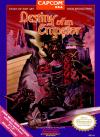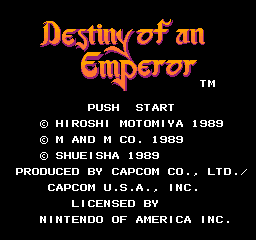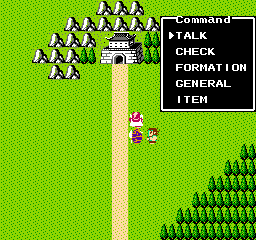Forum Links
Thread Information
Thread Actions
Destiny of an Emperor: not the most memorable game
01-08-17 12:51 PM
janus is Offline
| ID: 1323499 | 1928 Words
SecureYourCodeDavid
POSTS: 4615/4810
POST EXP: 565150
LVL EXP: 22630281
CP: 63448.9
VIZ: 536723

Destiny of an Emperor is a game based of Romance of the Three Kingdoms, which I never heard about before playing this game. So although I can’t compare the game’s accuracy to its muse, I can at least say one thing: it was not the most memorable game I have played in my life. Graphics: 7/10 For a game released in 1989, DOAE has average graphics. The characters you control and face look different (even subtly so) when you see them. Their design was a little flawed; they sometimes blend in with the background, especially when you walk on the red carpet in a castle. Most of their portraits are either pallet swaps or the same portrait with subtle changes (different length of mustache, of beard). One thing that was successful though was the “generational” changes; at one point or the other in the game the first three characters will “retire” and their sons will take their place. You can see the resemblance, and yet the difference is obvious (unlike the aforementioned swaps). Also your party is ALWAYS running, which was a big plus. Other RPGs have parties walking so slowly that you wonder when they will reach the next floor (like Dragon Warrior). The overworld map was done well and the various types of terrains were drawn well. Impassable mountains were done better than in the Dragon Warrior series; there are even “high peaks” (with clouds at the top), something I have never seen even on the PSX. The “northern region” is all white; I don’t know if it was intended to be snow but it was a nice distinction. There was also a nice distinction between the various settlements you come across. Castle towns have the actual castle showing (similar to DW III), whereas small villages only show a few houses. The graphics inside villages were decent enough. They come in various shapes and sizes and they never look alike. Later villages even show the mountains they are nested between; you couldn’t quite see the mountains when you enter Nibel in Final Fantasy VII. There are some “red doors” showing strategic places (inn, item shop, place where you can save/invite Liu Bei). A few villages even have cherry blossom trees, which looked nice and pink. Fortresses, however, look rather weak. I don’t know if it how the Chinese built their fortresses, but they looked more like Roman camps, like the ones you would see in Asterix, with wooden palisades and tents. And they all seem to be in the middle of a desert. Dungeons were made better. While their template is repeated over and over again, at least each floor is distinct from the other. There is always one with mint flavor Finally, battles were rather disappointing. You are on a completely black screen, where you only see your army and your opponents’. Their movements are minimal and you can barely see their strategies (magic, really) unless you stick your nose to the screen. That’s how I was able to see a small wave when someone uses a “water” technic. Hell, you don’t even see Si Ma Yi’s lighting technic; you only see the flash of light that fatally strikes you. Music: 6/10 Games of the Final Fantasy and Dragon Warrior series are well-known for their excellent music that enhances the gameplay. Certain tracks have become classics and music lovers like me remember them fondly. No such memory will exist with DOEA. While faithful to its setting (China), the soundtrack suffers greatly from the NES sound chip limitations. Sure, the village tracks sound more “Eastern” but the arrangements used are just plain annoying. The castle music was plainly a miss, with its high-pitch arrangements that are played too quickly and barely sound regal. The dungeon music was slightly better, with the main track having the right amount of mystery to it. However the background drum track was much too upbeat, as if it were trying to make people dance for some reason. The battle themes were really the best tracks in the game. The regular battle theme was upbeat and interesting and it compares advantageously to other RPGs of the time. When you walk on the overworld map you will sometimes meet more than just rebel forces of brigands; seeing those generals will give you a different, more dramatic track showing the enhanced difficulty. Trying to liberate towns from evil generals gives an even more dramatic track that is even more upbeat. Finally the “major boss” battle track (against the Si Ma family mainly) sounds VERY dramatic, and highly reflective of the difficulty – the toughest general has over 40k soldiers! Sound effects, on their side, are below average. All weapons sounds and look the same, and the only distinctive sound comes from attack technics. Even that was evened out; there is either a successful (like a chime) or a failure (a short “womp womp”) sound. Like later DW you hear a sound when you hit an obstacle, but its repetition isn’t constant. Addictiveness: 1/10 I will be dead honest: I did not feel like I wanted to come back to this game when I was playing it. The game is limited to traveling to towns/fortresses in order to liberate them from the enemy, rinse, wash and repeat. The game is so focused on the main plot that it forgot the essence of RPG: sidequest. Even FF I (with the rat tail) did it better. And with few exceptions, once a castle is liberated the story quickly moves on and forgets about it. For example you never have to come back to Xu Zhu once you conquer the Yellow Scarves at the beginning. Another thing I hated was the “Chineseness” of all the names. I know the game is set in China, and I can “forgive” the Chinese name structure (last name first), but it became impossible to know about the strategies without a proper guide. Anyone who masters Mandarin (Cantonese?) could probably understand what the various strategies are, but the average North American has no idea what An Sha, Ce Mian, Bei Jin or Jin Mia mean. Some are obvious once you use them (Bei Jin increases attack), but the fire and water attack strategies are rather impossible to know about unless the opposing army uses the opposite defense technic against them – your attack will therefore be weaker. And once you conquer the final boss, I can’t say I felt much relief or excitement for defeating him. That how uninterested I was in the main story; DW I had it better. Story: 7/10 The story starts with three very close friends: Liu Bei, Guan Yu and Zhang Fei. Together they pledge to always stay close together. Then the screen switches to Liu’s mother, who tells them that the Yellow Scarves are terrorizing the region and that you should visit the neighboring castle to volunteer to defeat them. You do, since you are a descendant of the Han Dynasty and that you should restore peace to the land of your ancestries. Once you do conquer them Liu becomes ruler of the region while Guan and Zhang continue to pacify the country to restore its previous harmony, with Liu’s son at your side. In other words the story is average. However it’s pleasant to go beyond the classical saving the damsel in distress or save the world from its impending doom. Here, it’s all about conquest. Depth: 3/10 However, as I said above the story doesn’t offer much else other than the regular story line (its speedrun did last over an hour and 20 minutes). Nearly everyone you recruit has absolutely no background; they are just there to offer their services to you. Those that may join you on the battlefield will at most ask for money or a steed to join; you won’t even hear from them once they join. Even the three main characters don’t have much to offer. Hell you never meet their wives; you only see their sons. And the few sidequests you do have and far between each other. In one of them you bring iron ore to a smith who makes excellent swords but the get stolen by thieves and it takes a while before you can get them all back. There could have been a few more fights against brigands to spice thing up a little rather than hide them in caves without much mystery (except the first one you see, that seems “imbued with evil energy”). And unless you knew the Romance story beforehand, I guess you will be at a loss like I was. Because after liberating an area, another one will cry for help because such and such evil general declared himself emperor or killed the previous one. Difficulty: 6/10 At least the difficulty level was reasonable. Like many RPGs you need to grind your level a little before moving on. But this one is not excessive; I really only grinded 2-3 levels in the very beginning before liberating my first fort. Afterwards the regular programmed battles (and a few random ones here and there) give you enough experience to increase your level to a decent amount. Plus starting about mid game you can buy power pills which make you hit critically unless an enemy strategy keeps you from attacking. And they only cost 50 gold; you can easily stock them after each battle (but your inventory is limited to 8 slots, so you will need to do it often). Speaking of battle, the “liberation” ones give you so many rations that you shouldn’t ever need to buy any. Just know that the more soldiers you control the more they eat during battle, so always watch your ration level after every fight. As I said above knowing what strategy does what can only be learned by trial and error (or through the proper strategy guide), which I found most frustrating. Plus, just like Super Mario RPG: Legend of the Seven Stars the strategy points are pooled for the WHOLE team. This makes choosing the right strategist vital if you want enough points to get by the later fights. Because Ce Mian (that blocks enemy strategies) uses 17 points (and can expire), leaving very few points to invoke a healing strategy if needed. Finally you can only use your gullwing to certain places. This gets very frustrating in the later game since your farthest warp point is Ru Nan Castle. If you want to backtrack to stock up on provisions you have to go through all the caves and forested fields (with a higher encounter rate) to go towards the final castle. Speaking of encounter, the rate was frustratingly high. You will see it in the videos I created: I sometimes gave up trying to polish my run because I would fight after every step or so. In short, Destiny of an Emperor is not a game I can really recommend. It is too focused on the main story – which is okay at best – there is barely any character development and the Chinese names used for the technics and villages will confuse you. Hell, sometimes the name of the place where you warp doesn’t even correspond to the actual name of the village. Too bad that its original battle system (up to five generals with their soldiers, plus a strategist giving you a few technics to use) wasn’t enough to save the game. |
YouTube Video Editor
| the unknown |
Affected by 'Laziness Syndrome'
Registered: 12-14-12
Location: Murica
Last Post: 1 day
Last Active: 13 hours
01-08-17 01:14 PM
 Lexatom is Offline
| ID: 1323501 | 56 Words
Lexatom is Offline
| ID: 1323501 | 56 Words
 Lexatom is Offline
Lexatom is Offline
LunarDarkness2

POSTS: 3420/5106
POST EXP: 331704
LVL EXP: 24130355
CP: 27083.7
VIZ: 723033

This is a great review. I prefer reviews to be a bit shorter in length, not too big and not too long, but that's just a personal preference of mine and I don't think that should dictate whether or not I like the actual review. Great job on this, can't wait to read your next review. |
| The Dragon of Rock Bottom |
Affected by 'Laziness Syndrome'
Registered: 07-30-13
Location: Denver, CO
Last Post: 1003 days
Last Active: 154 days
01-08-17 03:54 PM
janus is Offline
| ID: 1323529 | 25 Words
SecureYourCodeDavid
POSTS: 4616/4810
POST EXP: 565150
LVL EXP: 22630281
CP: 63448.9
VIZ: 536723

The review is proportional to the size of the game, usually. I have some other reviews under 1k words because the game is so short |
YouTube Video Editor
| the unknown |
Affected by 'Laziness Syndrome'
Registered: 12-14-12
Location: Murica
Last Post: 1 day
Last Active: 13 hours


 User Notice
User Notice 






